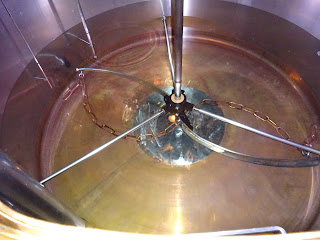The Golden Pint is not made
but grows on a green tree:
A strong man with his crystal eyes
is a man born free.
The oxen pass under the yoke
and the blind are led at will:
But a man born free has a path of his own
and a house on the hill.
And men are men who till the land
and women are women who weave:
Fifty men own the lemon grove
and no man is a slave.
And to think they gave Herbert Read a knighthood when he can't even get a rhyme right, the women should clearly have been waving. Just shows how ridiculous the honours system is. Anyway, the Golden Pints are not something I take notes for but I'll see what I can dredge up from my memory for the past year.
Best UK Cask Beer:
I have undoubtedly drunk more from Thurstons brewery than anything else but this year but a pub I go to in Dorking has started regularly, but not always, having Timothy Taylor's Landlord on and my eyes light up whenever I see it so it's got to be Landlord.
Best UK Keg Beer:
The have been at least three occasions this year when I have suckled from the Devil's drainpipe, a couple of them even of my own free will. The Hog's Back beers drunk under duress when I went to see the mighty Hawkwind weren't anything special and cask would definitely have been an improvement. Thurstons trial of their Saison on keg was a must and if it becomes a regular thing could imperil my immortal soul. But the winner is one from Abbeydale. After a long session on Harvey's excellent cask beer I was tempted into the Rake for one more. As the cask there isn't great I couldn't help but think it was a disappointment. So we eyes wandered to see what was in the over chilled and carbonated section. Spying a Brett. beer I went for it and I have to say it was well done. So the winner is a bretty pale ale from Abbeydale.
Best UK Bottled Beer:
Small pack beer for me this year has mostly been stuff blagged from work. Beer's so much cheaper when you don't pay for it! Mostly I think it was Ridgeway beers, I've definitely developed a taste for one of the Bad Elves. The winner is one my favourite sister bought me though: Tynt Meadow. I'd wanted this beer for a long while and it's very good indeed.
Best UK Canned Beer:
Again, work has proved fruitful for cans thanks to Laine brewery so I'll go with All For One from them.
Best Overseas Draught:
Did I go overseas this year? Oh yes, Germany. Can't say I was overwhelmed with any of the normal lagers but I was quite taken with the Schlenkerla so that.
Best Overseas Bottled Beer:
For this one the winner's got to be Obadiah Poundage though, what a beer.
Best Overseas Canned Beer:
Hmmm...did I have anything canned from overseas. Don't think so.
Best collaboration brew:
Not really my thing.
Best Overall Beer:
Lovely, lovely Landlord.
Best Branding:
What's Lindsay at Too Much Black Coffee done this year? Oh yes, VIPA.
Best UK Brewery:
I know Landlord won best beer but I've never been as keen on the rest of their range so Thurstons can have this one. The Milk Stout's too sweet mind.
Best Overseas Brewery:
Let's stick with Schlenkerla.
Best New Brewery Opening 2019:
No idea.
Pub/Bar of the Year:
It can only be The Champion Pub of Surrey: The Crown, Horsell.
Best New Pub/Bar Opening 2019:
No idea for this one either.
Beer Festival of the Year:
The GBBF wasn't a vintage year for me this this time round, but it's still the best festival.
Supermarket of the Year:
Not had much call for supermarket beer this year.
Independent Retailer of the Year:
I've used it as a pub more than a shop but Cobbetts Real Ale.
Online Retailer of the Year:
Not bought any beer online.
Best Beer Book or Magazine:
Boak and Bailey's Balmy Nectar mentions me by name, thus making me even more famous. So it should be a shoe in, but unfortunately for them also published this year was The Craft Brewing Handbook, surely one of the greatest books ever written, so it's got to be that.
Best Beer Blog or Website:
Martyn Cornell has had some cracking posts recently, making a trip to try Mercers Meat Stout and breaking the fantastic news that confirms Fuggles aren't a continental interloper and that they're descended from Goldings so demonstrating that Farnham Whitebines really are the daddy of them all. Well, mummy really.
But no competition can see off Boak and Bailey in the blog stakes, they tirelessly bring out a stream of interesting stuff to read, so they're the champions this year.
Simon Johnson Award for Best Beer Twitterer:
For coming up with a beer that's truly innovative (I mean, have you ever heard of another beer made with hop leaves?) Danielle Bekker @BinaryBotanical has got nothing but stick on twitter. Those crafties love innovation provided it tastes of American hops. Yet despite all the stick she's never told anyone to go do one which surely deserves an award. So here one is.































































